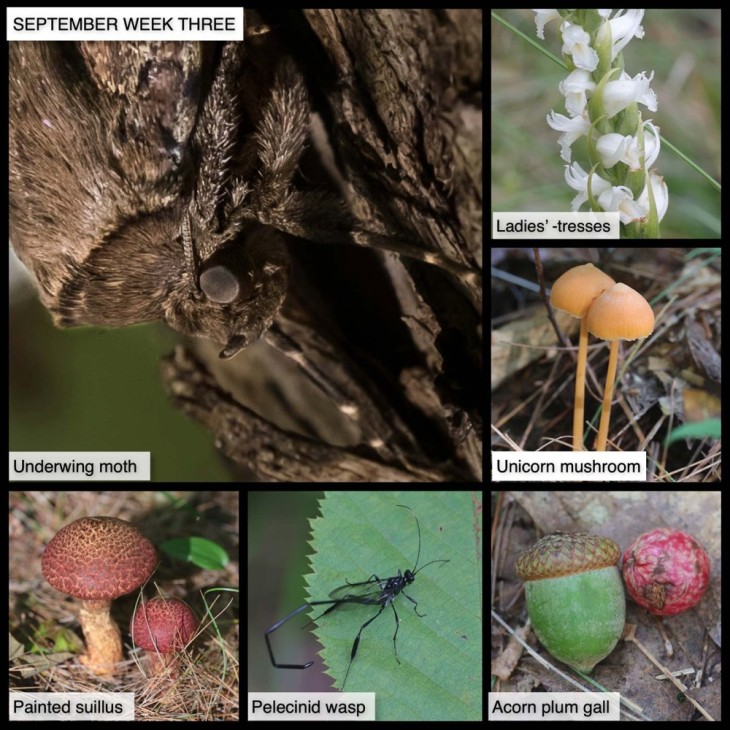This Week in the Woods, we brushed up against some tree bark, and it flew away, flashing pink stripes as it went. Happily, this underwing moth didn’t go far. Once it had settled back into a characteristic upside-down perch, it posed for this macro shot (check out its bat-like face!). As noted in this post by the University of Wisconsin Milwaukee’s “Bug Lady,” underwings (many species) are part of the owlet moth family. They’re nocturnal, and incredibly well-camouflaged, so you need a good dose of luck to find one. Thanks to Tig Tillinghast for sharing this image.
Here are some other nature sights this week (clockwise):
We’ve found more than one species of ladies’-tresses blooming this week (the one in the photo is probably, but not definitely, yellow ladies’-tresses). According to this post from the North American Orchid Conservation Center, there are about 25 species world-wide. Marilyn Dwelley, in her field guide Summer and Fall Wildflowers of New England, notes that nodding ladies’ tresses are also “called Pearl-Twists and Screw-Augurs because the arrangement of small flowers appears to twist around the stem.” Here’s an article by Susan Shea from the Spring 2019 issue of Northern Woodlands describing orchid biology and work to conserve wild orchid species. Some of the images in this article are by the late, great Jim Fowler, an author, field botanist, and leading advocate for orchid conservation.
It’s unicorn season. The pointy topped caps of unicorn mushrooms (two common species) are appearing in small clusters in the woods now. We’re fairly sure this is a salmon unicorn mushroom, which typically grows in moss under conifers. Here’s a profile from mushroom expert Michael Kuo.
A reader (hi, Sharon!) recently sent us a photo showing a handful of rosy speckled orbs she’d picked up from the ground beneath an oak tree. These are acorn plum galls, and they form in response to a wasp laying its egg in an oak’s tissues, along with chemicals that prompt abnormal growth. The wasp larva and its gall “crib” grow up together, and eventually, the gall falls down to the forest floor. Here’s a post about acorn plum galls from Michigan State University.
Speaking of wasps, this terrifying-looking but harmless (to humans) insect is a female pelecinid wasp. These wasps (only one species in North America) are active in August and September and are parasitoids of the soil-dwelling larvae of June beetles. The female wasp inserts its long abdomen into the soil and lays her eggs into the beetle larvae, which then feed on their living hosts, eventually killing them. You can read more about pelecinid wasps in this “BugLady” post. Jeffrey Hahn, in his field guide Insects of the North Woods, also noted the female’s swollen looking back legs.
Finally, we’ve been noticing a variety of different boletes growing in the woods, including the distinctive painted suillus. As Larry Millman notes in Fascinating Fungi of New England, this mushroom is distinguished by “conspicuous red to dark-red fibers” on its cap, a scaly stalk, and yellow pores. Look for it growing under eastern white pine trees.
Our thanks to The Bailey Charitable Foundation and the Frank and Brinna Sands Foundation for helping to support this series.
In this difficult period, many of us find joy in observing local nature. This series, launched in April 2020, shares nature photographs taken in the past seven days, or in the same week in 2020, most within 15 miles of the Northern Woodlands office in Lyme, New Hampshire. We hope you enjoy using this grid as a prompt for your own explorations.
What are you seeing in the woods this week? Share your images with us on Facebook, or submit a special photo for possible inclusion in our monthly online Reader Photo Gallery.


